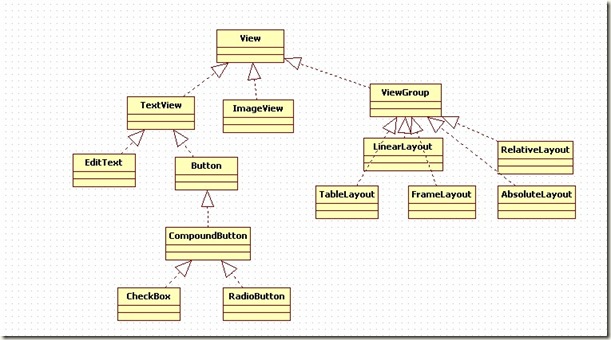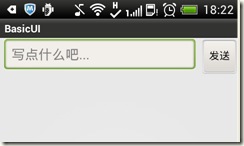Android 步步为营 第5营 代码控制UI,View
来源:互联网 发布:腾讯视频会员软件 编辑:程序博客网 时间:2024/05/16 07:27
原文:http://www.cnblogs.com/vivid-stanley/archive/2012/08/22/2651399.html
在前面的几讲中,我们都是使用xml layout 来去控制UI组件,其实我们也可以完全抛开XML,用纯代码来控制我们的界面UI。
回顾我们学过的,遇到过的UI组件,有容器类的Layout:LinearLayout,RelativeLayout等, 也有视图类UI:TextView, EditText, Button, ImageView等。对应到代码中,我们会发现,他们都是View子类,具体关系如下:

Tips:在Eclipse中,可以用Ctrl+T键来查看某个类的类层次关系:

ViewGroup 与View 的关系,是一个典型的“组合”设计模式。
我们来用代码,实现一个简单的UI布局:
![L{HDSP]0NSR]QI`@V%UPVMF L{HDSP]0NSR]QI`@V%UPVMF](http://images.cnblogs.com/cnblogs_com/vivid-stanley/201208/201208222002315085.jpg)
只有一个EditText和一个Button, 看看代码是怎么写的:
public class MainActivity extends Activity { @Override protected void onCreate(Bundle savedInstanceState) { super.onCreate(savedInstanceState); LinearLayout container = new LinearLayout(this); container.setOrientation(LinearLayout.HORIZONTAL); this.setContentView(container); EditText content = new EditText(this); content.setHint("写点什么吧..."); Button submit = new Button(this); submit.setText("发送"); container.addView(content); container.addView(submit); }}
我们来分析一下代码,
不管LinearLayout, EditText 还是Button, 他们的构造函数都是this. 其实查看源码后我们发现,所有的View及其子类的构造都至少包含三个构造方法:
public View(Context context)public View(Context context, AttributeSet attrs)public View(Context context, AttributeSet attrs, int defStyle)
后两个是为XML layout 定义的,用代码创建View时,一般都是用第一个构造函数,这里用this, 是因为Activity其实就是Context的子类。
this.setContentView()这个方法,以前我们都是传一个R.layout进去,其实它有多个重载,也可以直接传入根视图View。
这里的线性布局container 就是根视图(容器视图),要往容器视图里面添加View,使用addView方式,addView 方法有几个重载版本:
public void addView(View child)
public void addView(View child, int index)
public void addView(View child, int index, LayoutParams params)
public void addView(View child, int width, int height)
public void addView(View child, LayoutParams params)
LayoutParams 我们之后会讲到。
总结一下,用代码添加UI组件的步骤是:
- New 组件对应的类;
- 把它添加到父容器中。
运行结果就如上图的一样。你也许会想到,不是说width, height是必须的吗?怎么没有设置也可以啊?是因为,addView默认使用wrap_content.
但是光是这样不够,我们还想添加边距,权重等。
为View指定LayoutParams
添加宽,高,边距,权重这些属性,对应的类是LayoutParams,它一般都是作为一个内部类出现在某个ViewGroup的子类中。对于线性布局,我们使用LinearLayout.LayoutParams,
weight, leftMargin, rightMargin…..这些属性都在它的公有变量里面。
LinearLayout.LayoutParams contentLayoutParams = new LinearLayout.LayoutParams(0, LinearLayout.LayoutParams.WRAP_CONTENT); contentLayoutParams.weight = 1; contentLayoutParams.leftMargin = 10; container.addView(content, contentLayoutParams); LinearLayout.LayoutParams buttonLayoutParams = new LinearLayout.LayoutParams( LinearLayout.LayoutParams.WRAP_CONTENT, LinearLayout.LayoutParams.WRAP_CONTENT); buttonLayoutParams.leftMargin = 10; container.addView(submit, buttonLayoutParams);
在addView之前,我们设置好LayoutParams 的值,调用addView(View child, LayoutParams params)这个重载方法。

相对布局的RelativeLayout.LayoutParams
我们来看看, 在代码中,调用那些方法来定位布局
因为在相对布局中, 定位的方法有很多种类,所以API提供了一个统一的方法:
addRule(int verb, int anchor)
addRule(int verb)
verb是动词的意思,就是用来表达above, below, toRightOf, toLeftOf, alignParentLeft…..等等。
这些动词的int 值在RelativeLayout下有常量定义。例如:
RelativeLayout.ABOVE
RelativeLayout.BELOW
RelativeLayout.ALIGN_LEFT
RelativeLayout.LEFT_OF
RelativeLayout.RIGHT_OF
anchor的值,可以是RelativeLayout.TRUE,0表示false, 或者其它View 的Id, 根据具体的verb, 填入相应的值:
@Override protected void onCreate(Bundle savedInstanceState) { super.onCreate(savedInstanceState); this.setContentView(this.addRelativeLayout()); } private RelativeLayout addRelativeLayout() { RelativeLayout container = new RelativeLayout(this); Button btn1 = new Button(this); btn1.setId(11); btn1.setText("上"); Button btn2 = new Button(this); btn2.setId(12); btn2.setText("下"); Button btn3 = new Button(this); btn3.setId(13); btn3.setText("左"); Button btn4 = new Button(this); btn4.setId(14); btn4.setText("右"); Button btn5 = new Button(this); btn5.setId(15); btn5.setText("中"); RelativeLayout.LayoutParams lp1 = new RelativeLayout.LayoutParams(100, RelativeLayout.LayoutParams.WRAP_CONTENT); RelativeLayout.LayoutParams lp2 = new RelativeLayout.LayoutParams(lp1); RelativeLayout.LayoutParams lp3 = new RelativeLayout.LayoutParams(lp1); RelativeLayout.LayoutParams lp4 = new RelativeLayout.LayoutParams(lp1); RelativeLayout.LayoutParams lp5 = new RelativeLayout.LayoutParams(lp1); lp5.addRule(RelativeLayout.CENTER_IN_PARENT, RelativeLayout.TRUE); lp1.addRule(RelativeLayout.ABOVE, btn5.getId()); lp1.addRule(RelativeLayout.ALIGN_LEFT, btn5.getId()); lp2.addRule(RelativeLayout.BELOW, btn5.getId()); lp2.addRule(RelativeLayout.ALIGN_LEFT, btn5.getId()); lp3.addRule(RelativeLayout.LEFT_OF, btn5.getId()); lp3.addRule(RelativeLayout.ALIGN_BASELINE, btn5.getId()); lp4.addRule(RelativeLayout.RIGHT_OF, btn5.getId()); lp4.addRule(RelativeLayout.ALIGN_TOP, btn5.getId()); container.addView(btn5, lp5); container.addView(btn1, lp1); container.addView(btn2, lp2); container.addView(btn3, lp3); container.addView(btn4, lp4); return container; }
注意:LayoutParams的构造函数也可以是另外一个已经存在的LayoutParams对象,他的width, height值被克隆到当前对象中去。
![H$5Z~Y`M$QI]095GSLL9HBH H$5Z~Y`M$QI]095GSLL9HBH](http://images.cnblogs.com/cnblogs_com/vivid-stanley/201208/201208222002339314.jpg)
FrameLayout, TableLayout的LayoutParams, 读者可自行研究一下。
- Android 步步为营 第5营 代码控制UI,View
- Android代码控制UI,View
- 代码控制UI,View
- Android复习第1课:在代码中控制UI界面
- Android在代码中控制UI界面
- Android 视频播放控制View核心代码
- Android中的UI界面控制方式和自定义View
- 第一行代码Android-------布局和UI
- 【第一行代码】Android中UI总结
- 《Android第一行代码》之UI
- 代码控制UI界面
- 代码控制UI界面
- [Android][第一行代码][第 3 章 View]
- 【Android开发】用户界面设计-在代码中控制UI界面
- Android UI控制方法
- 《第一行代码--Android》读书笔记之UI篇
- View组件及UI界面控制方法
- Android UI设计之<十二>自定义View,实现绚丽的字体大小控制控件FontSliderBar
- 当你对未来迷茫的时候请看看(工资2000的人看2遍,3000的看3遍,5千看5遍,1万以上的请背下它)
- IE10一些好玩好用的小技巧,事半功倍
- Android中Spinner下拉列表(使用ArrayAdapter和自定义Adapter实现)
- 最简的restful webservice实现,提供get和post服务(提供war包下载)
- Windows核心编程学习一:使用DialogBoxParam显示模式对话框
- Android 步步为营 第5营 代码控制UI,View
- mac os 安装 pkg-config
- OpenLDAP的安装配置[转]
- paip.多线程调用静态方法错乱的解决
- 第五堂作业 1.3
- 推荐一个压力测试工具stressmark
- 我的Android进阶之旅------>Android用PopupWindow实现弹出菜单实例
- [ExtJs]Grid合计
- 远程服务器返回错误 (411) 所需的长度。



